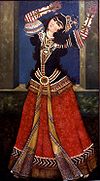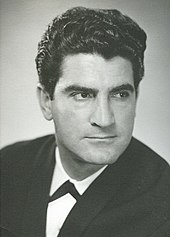The Persians are an Iranian ethnic group who comprise over half of the population of Iran. They share a common cultural system and are native speakers of the Persian language as well as of the languages that are closely related to Persian.

Shahre Ray, Shahr-e Ray, Shahre Rey, or Shahr-e Rey or simply Ray or Rey (ری), is the capital of Rey County in Tehran Province, Iran. Formerly a distinct city, it has now been absorbed into the metropolitan area of Greater Tehran as the 20th district of municipal Tehran, the capital city of the country.
Persian traditional music or Iranian traditional music, also known as Persian classical music or Iranian classical music, refers to the classical music of Iran. It consists of characteristics developed through the country's classical, medieval, and contemporary eras. It also influenced areas and regions that are considered part of Greater Iran.
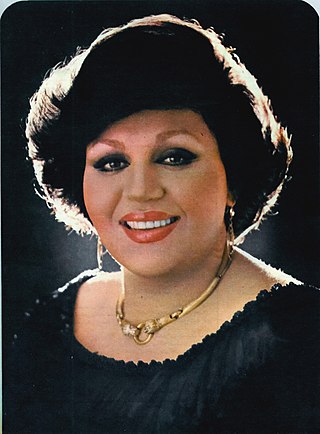
Ma'soumeh Dadehbala, known professionally as Hayedeh, was an Iranian singer with a contralto vocal range. Known for her wide range of voice, her career spanned over two decades, and she has been widely described as one of the most popular and influential musicians of Iran.
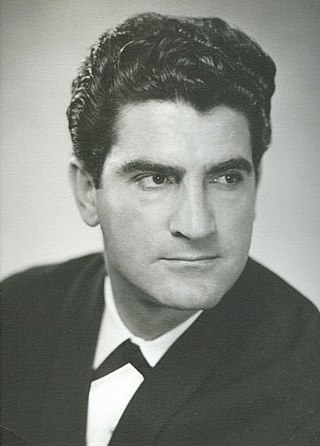
Viguen was an Iranian pop music singer and actor. He was well known throughout the Near East and was called the "King of Iranian pop" and the "Sultan of Jazz." He was an Iranian Armenian by ethnicity and sang in both Persian and Armenian.
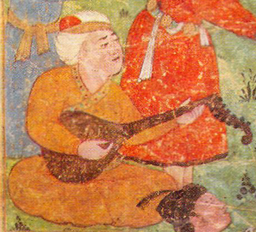
Barbad was a Persian poet-musician, lutenist, music theorist and composer of Sasanian music. He served as chief minstrel-poet under the Shahanshah Khosrow II. A barbat player, he was the most distinguished Persian musician of his time and is regarded among the major figures in the history of Persian music.
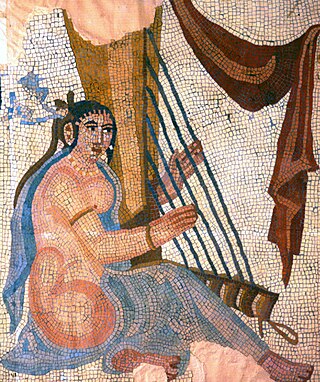
Sasanian music encompasses the music of the Sasanian Empire, which existed from 224 to 651 CE. Many Sasanian Shahanshahs were enthusiastic supporters of music, including the founder of the empire Ardashir I and Bahram V. In particular, Khosrow II was an outstanding patron, his reign being regarded as a golden age of Persian music.
Dastgāh is the standard musical system in Persian art music, standardised in the 19th century following the transition of Persian music from the Maqam modal system. A dastgāh consists of a collection of musical melodies, gushehs. In a song played in a given dastgah, a musician starts with an introductory gusheh, and then meanders through various different gushehs, evoking different moods. Many gushehs in a given dastgah are related to an equivalent musical mode in Western music. For example, most gushehs in Dastgāh-e Māhur correspond to the Ionian mode in the Major scale, whilst most gushehs in Dastgāh-e Šur correspond to the Phrygian mode. In spite of 50 or more extant dastgāhs, 12 are most commonly played, with Dastgāh-e Šur and Dastgāh-e Māhur being referred to as the mothers of all dastgahs.

New Persian, also known as Modern Persian is the current stage of the Persian language spoken since the 8th to 9th centuries until now in Greater Iran and surroundings. It is conventionally divided into three stages: Early New Persian, Classical Persian, and Contemporary Persian.
Symphonic music in Iran encompasses Iranian musical pieces composed in the symphonic style. In addition to instrumental compositions, some of Iran's symphonic pieces are based on the country's folk songs, and some are based on poetry of both classical and contemporary Iranian poets.

Ali-Naqi Vaziri, also transcribed as Ali Naghi Vaziri was a composer, thinker and a celebrated player of the tar. He is considered a revolutionary icon in the history of 20th-century Persian music.

Hormoz Farhat was a Persian-American composer and ethnomusicologist who spent much of his career in Dublin, Ireland. An emeritus professor of music, he was a fellow of Trinity College, Dublin. Described by the Irish Times as a "gifted and distinctive composer of contemporary classical music," his compositions include orchestral, concertante, piano and choral music, as well string quartets and chamber works. He also wrote numerous film scores, including that of Dariush Mehrjui's 1969 film The Cow. However, his musicological research dominates his legacy; his writings on the music of Iran—a country which he insisted be called 'Persia'—were pivotal in ethnomusicology, particularly his acclaimed 1990 study The Dastgah Concept in Persian Music.
Iranian folk music refers to the folk music transmitted through generations among the people of Iran, often consisting of tunes that exist in numerous variants.
Bamshad or Bāmšād was a musician of Sasanian music during the reign of Khosrow II.
Master Farâmarz Pâyvar was an Iranian composer and santur player. Payvar died on 9 December 2009 after a long struggle with brain damage. Although once perceived as marginal, the santur is now considered an important solo instrument in Persian classical music, largely as a result of his work. Over the course of his career, Payvar revolutionised its playing, led two major ensembles and made numerous recordings.
Reza Vohdani was an Iranian musician.

Amir Houshang Ostovar was a Persian symphonic music composer and Instructor.
Iranian piano refers to the techniques for tuning, playing and composing for the piano which were developed by Iranian musicians in the nineteenth and twentieth centuries. Persian piano music refers to piano pieces that are based on Persian traditional music or to pieces by Persian (Iranian) composers for the piano.

Gholam-Reza Minbashian, also known as Salar Mo’azez (1861-1935) was a Persian composer and conductor of State Military Band in Tehran. Gholam-Reza Minbashian is recognised as the first Persian to have received an education in classical music abroad and the first Persian composer whose work was published in Europe. Among other compositions, he composed a national march for the liberation of Tehran.
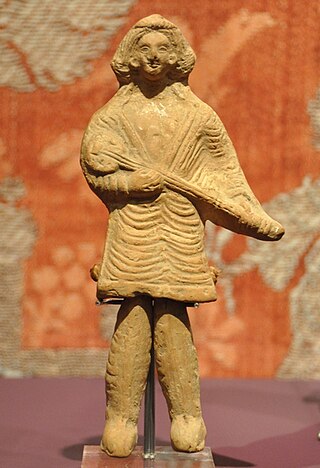
The Parthian Empire, a major state of ancient Iran, lasted from 247 BCE to 224 CE, in which music played a prominent role. It featured in festivals, weddings, education, warfare and other social gatherings. Surviving artistic records indicate that it involved both men and women, who could be instrumentalists or singers. Along with the older music of the previous Achaemenids, Medians and Assyrians, Parthian music was crucial in laying the foundation for the golden age of subsequent Sasanian music.
